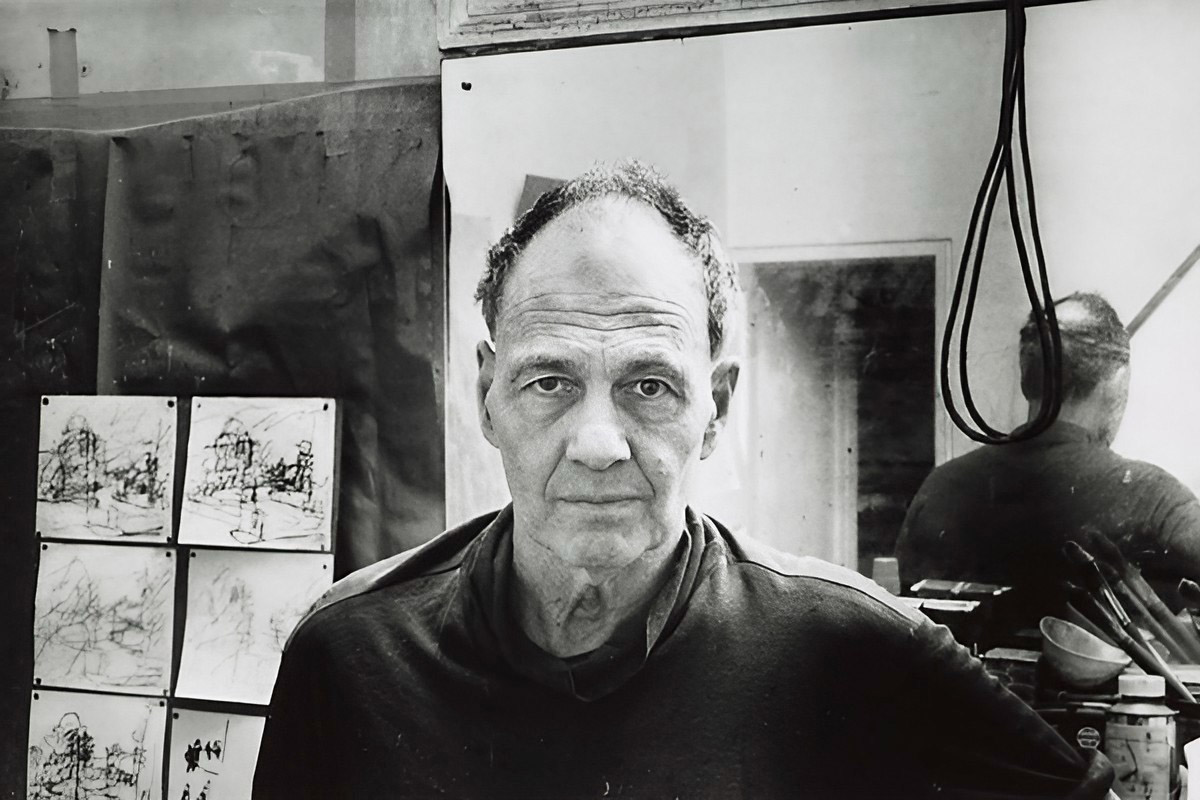A tribute to former London Group member by David Redfern LG and Peter Clossick PPLG

The death of Frank Auerbach is a huge loss to British art and no doubt there will be many obituaries, articles, surveys and exhibitions to come. Auerbach came to this country just before the Second World War fleeing the Nazis in Germany. In 1947 he attended classes at the Borough Polytechnic taught by London Group founder member David Bomberg. Auerbach first exhibited with The London Group as a non-member selected from an open submission in 1953 at the “London Group”, Annual Exhibition in the New Burlington Galleries. Fellow exhibitors included Sandra Blow, Prunella Clough, Merlyn Evans, Anthony Eyton, Albert Irvin, Peter Lanyon, Mary Martin, Henry Mundy, John Piper, John Plumb and Euan Uglow. His first one-person show was at the Beaux Arts Gallery in 1956 and he also showed as a non-member in that year’s London Group exhibition along with Gillian Ayres, John Bratby, Prunella Clough, Anthony Eyton, Patrick George, Roger de Grey, Mary Martin, Dorothy Mead, Margaret Mellis, Henry Mundy, Leonard Rosoman, Adrian Stokes, Michael Tyzack and Euan Uglow. After these years of non-member selection Auerbach was finally elected to The London Group in 1960 with Andrew Forge and Dorothy Mead, the latter soon to be elected as the first female president of the Group. The Borough Group of artists under the “leadership” of David Bomberg soon became a dominant influence within The London Group; Dennis Creffield was elected in 1962 and Leon Kossof in 1963. What a formidable arsenal to call upon for powerful exhibitions. By 1961 he was active in the Group’s administration, in a meeting criticizing the Group’s election process as “a chaotic and unworkable ad hoc system”. By the following year he had put himself forward to serve on the new selection and election committee. 1963 sees him on the selection committee for the Group’s open submission exhibition, serving with Claude Rogers, Anthony Hatwell, Jeffery Camp, Anthony Eyton, William Gear, Adrian Heath, Robert Medley, Brian Wall and H.S. Williamson. In a review of the exhibition, John Russell writing in the Sunday Times noted, “Cliff Holden, Andrew Forge, Leslie Marr, Dorothy Mead, Leon Kossoff, Frank Auerbach, Dennis Creffield and Peter Richmond all present in strength (essentially the Borough Group), the visitor can familiarise himself with a kind of painting which even now does not ‘take’ with the dealers.” However, by 1964 Auerbach had stepped down from committee work and in 1965 he resigned, not for him the shackles of meetings and minutes. The previous year the Tate Gallery had been the venue for “1914-64 Jubilee Exhibition: Fifty Years of British Art”, The London Group’s prestigious 50th anniversary exhibition. Interestingly Auerbach was not shown although his Borough Group colleagues Bomberg, Kossoff, Creffield, Mead, Hatwell and Holden were. What happened here? As Auerbach left The London Group, Albert Irvin, Paula Rego and Michael Sandle joined it and the cycle continued. Perhaps his relationship can be seen as an atypical London Group experience, a young artist given critical exposure early in their career, an opportunity to shape the direction of the Group along with fellow artists and finally a desire to go their own way especially when their work finally “takes with the dealers”.
David Redfern LG, 2024

When elected president in 2000, I tried to tempt previous illustrious members back into the group, with Frank Auerbach being one of them. When I phoned Frank, he responded, “I do not like being part of a group.” I knew Frank through his model, Juliet Yardley Mills (J.Y.M.), who sat for me and did so for years until she passed. I visited Frank in his Mornington Crescent Studio, Camden, where I grew up. He was always extremely kind and supportive. I organised the framing of prints he gave Jym, which he paid me for, and once wrote, “It seems a bit fatuous, but I do feel that you are getting better all the time, which is not true of most of us”. The man was so generous: “I am still tottering about, repainting pictures. I hope you are in good fettle and working well”.I was naturally delighted he thought so well of me and even helped critique some of my work. “Of course you are special”, he wrote, “I have sometimes been impressed by your work, and I value your association with, and kindness to, Jym.”
Frank Auerbach was from a previous generation who knew about integrity rather than any commercial glitz. Jym, who sat for him for over thirty years, described the experience to me:
“He is indifferent to physical discomfort, intensely engrossed, carrying the same attitude to all he does. Unaware of himself whilst working with jerky, uptight movements. The strain, because of the intensity, can be enormous. You feel like someone is being looked at through an eyeglass or under a microscope. His look is completely and utterly direct. You look at him, not moving, but static, watching each other. There is an easy give-and-take between you, giving to each other. He never looks at the clock; time has no meaning. There is a rhythm of work, and you talk and relax in silence. It is not necessary to talk. The experience is exciting and thrilling.”
Frank will be sorely missed, and I feel sad he is no longer with us.
Peter Clossick PPLG, 2024







